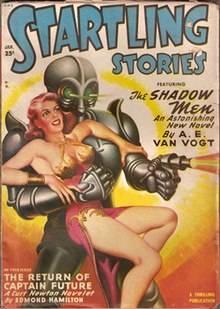
Back Startling Stories Spanish Startling Stories French Startling Stories ID Startling Stories Italian スタートリング・ストーリーズ Japanese

Startling Stories was an American pulp science fiction magazine, published from 1939 to 1955 by publisher Ned Pines' Standard Magazines. It was initially edited by Mort Weisinger, who was also the editor of Thrilling Wonder Stories, Standard's other science fiction title. Startling ran a lead novel in every issue; the first was The Black Flame by Stanley G. Weinbaum. When Standard Magazines acquired Thrilling Wonder in 1936, it also gained the rights to stories published in that magazine's predecessor, Wonder Stories, and selections from this early material were reprinted in Startling as "Hall of Fame" stories. Under Weisinger the magazine focused on younger readers and, when Weisinger was replaced by Oscar J. Friend in 1941, the magazine became even more juvenile in focus, with clichéd cover art and letters answered by a "Sergeant Saturn". Friend was replaced by Sam Merwin Jr. in 1945, and Merwin was able to improve the quality of the fiction substantially, publishing Arthur C. Clarke's Against the Fall of Night, and several other well-received stories.
Much of Startling's cover art was painted by Earle K. Bergey, who became strongly associated with the magazine, painting almost every cover between 1940 and 1952. He was known for equipping his heroines with brass bras and implausible costumes, and the public image of science fiction in his day was partly created by his work for Startling and other magazines. Merwin left in 1951, and Samuel Mines took over; the standard remained fairly high but competition from new and better-paying markets such as Galaxy Science Fiction and The Magazine of Fantasy & Science Fiction impaired Mines' ability to acquire quality material. In mid-1952, Standard attempted to change Startling's image by adopting a more sober title typeface and reducing the sensationalism of the covers, but by 1955 the pulp magazine market was collapsing. Startling absorbed its two companion magazines, Thrilling Wonder and Fantastic Story Magazine, in early 1955, but by the end of that year it too ceased publication.
Ron Hanna of Wild Cat Books revived Startling Stories in 2007.[3] Wild Cat Books folded in 2013. A statement of the closure is still posted on the Facebook page All Pulp dated March 12, 2013 (as of January 29, 2019). The magazine was again revived by John Gregory Betancourt's Wildside Press in February 2021, with Douglas Draa as editor.[4]
- ^ di Fate (1997), p. 35.
- ^ Rikke Schubart, Super bitches and action babes: the female hero in popular cinema, 1970-2006, page 225, McFarland & Co., 2007, ISBN 0-7864-2924-0
- ^ Edwards, Malcolm & Ashley, Mike. "Culture: Startling Stories: SFE: Science Fiction Encyclopedia". Science Fiction Encyclopedia. Gollancz. Retrieved February 1, 2017.
- ^ ONeill, John. "Startling Stories Returns." Article on blackgate.com, February 4, 2021.
© MMXXIII Rich X Search. We shall prevail. All rights reserved. Rich X Search